Curious about the brightest stars visible in the night sky? Discover our list of the top 10 most brilliant celestial bodies that can be easily observed with the naked eye. But before we delve into that, let’s take a brief journey through history.
An overview of stellar magnitude throughout time
Around 120 years before Christ, the Greek astronomer Hipparchus (Hipparchus) produced the initial catalog of stars that is recognized today. Although this document has not survived, it is believed that Hipparchus’ list contained approximately 850 stars. (Later, in the second century AD, another Greek astronomer, Ptolemy, expanded Hipparchus’ catalog to include 1022 stars. Hipparchus included in his list the stars visible in each known constellation at the time, carefully noting the position of each celestial body, and ranking them based on brightness from 1 to 6, with 1 representing the highest level of brightness (or “stellar magnitude”).
This technique for measuring brightness remains in use at present. It is worth mentioning that during Hipparchus’ era, telescopes did not exist, so the ancient astronomer could only discern stars with a brightness of the 6th stellar magnitude (the faintest) with the naked eye. In contrast, with contemporary ground-based telescopes, we can detect extremely faint stars with magnitudes as high as 22m. Meanwhile, the Hubble Space Telescope has the capability to detect objects with magnitudes up to 31m.
What is Apparent Stellar Magnitude?
Astronomers have started using decimal fractions, such as 2.75m, to indicate stellar magnitudes instead of simple numbers like 2 or 3. This change came with the development of more accurate instruments for measuring light.
Today, we are aware of stars with apparent stellar magnitudes that are brighter than 1m. For instance, Vega, the brightest star in the constellation Lyra, has an apparent stellar magnitude of 0. If a star is brighter than Vega, its stellar magnitude will be negative. For example, Sirius, the brightest star in our night sky, has an apparent stellar magnitude of -1.46m.
When astronomers discuss stellar magnitudes, they are usually referring to the “apparent stellar magnitude”. In these cases, a lowercase Latin letter m is typically added to the numerical value, such as 3.24m. This measurement represents the brightness of the star as seen from Earth, without accounting for the atmospheric conditions that can impact the observation.
Absolute stellar magnitude – what does it mean?
Nevertheless, the luminosity of a star is not the sole determinant of its brightness; the distance between the star and Earth also plays a crucial role. Take, for instance, a candle that you light at night. When you are in close proximity to it, it emits a brilliant glow, illuminating everything in its vicinity. However, if you were to step back 5-10 meters, the luminosity of the candle would no longer suffice, and its brightness would diminish. In other words, you would observe a disparity in brightness, even though the flame of the candle remained constant throughout.
The absolute stellar magnitude is typically denoted by a capital M, for example, 2.75M. This approach evaluates the true brightness of the star, without accounting for distance or other influences (such as gas clouds, dust absorption, or the scattering of the star’s light).
1. Sirius (“Dog Star”) / Sirius
All stars in the night sky emit light, but none emit light as brightly as Sirius. The name of this star originates from the Greek word “Seirius”, which translates to “burning” or “scorching”. With an absolute stellar magnitude of -1.42M, Sirius is the most luminous star in our sky after the Sun. This brilliant celestial object is situated in the constellation of Canis Major, commonly known as the Big Dog, hence its popular designation as the “Dog Star”. In ancient Greece, it was believed that the appearance of Sirius in the early minutes of dawn marked the beginning of the hottest part of summer, known as the “dog days” season.
Nevertheless, nowadays Sirius no longer serves as the signal for the start of the hottest part of summer due to the Earth’s gradual axial oscillation, which occurs over a 25,800-year cycle. This phenomenon causes the stars in the night sky to shift their positions.
Sirius shines 23 times brighter than our Sun, yet it has a diameter and mass that is only double that of our own celestial luminary. It is worth noting that the distance to Sirius is relatively small in cosmic terms, at 8.5 light-years. This proximity is a major contributing factor to the star’s brightness, as it is the fifth closest star to our Sun.
In 1844, Frederick Besse, a German astronomer, observed the wobble of Sirius and proposed that it could be caused by the presence of another star. After nearly two decades, in 1862, Bessel’s hypothesis was confirmed: Alvan Clarke, an astronomer, discovered with his new 18.5-inch refractor (the largest in the world at that time) that Sirius was not a single star but actually a binary system.
This significant finding led to the identification of a new category of stars known as “white dwarfs.” These stars possess an extremely dense core, as all of the hydrogen within them has already been exhausted. It has been calculated that Sirius’s companion, known as Sirius B, has the same mass as our Sun but is compressed to the size of Earth.
Locating Sirius: The optimal period for observing Sirius is during the winter months (for those in the northern hemisphere), as this is when the Dog Star becomes visible in the early evening sky. To locate Sirius, you can use the constellation Orion as a guide, specifically its three belt stars. By drawing a line from the leftmost star of Orion’s belt with a slight inclination of 20 degrees towards the southeast direction, you can pinpoint the position of Sirius. As a helpful tip, you can use your own closed fist as a measuring tool, as when held at arm’s length it covers approximately 10 degrees of the sky. Therefore, you will need to align approximately two fist-widths to accurately locate Sirius.
2. Canopus
Canopus, the second brightest star in the Earth’s night sky after Sirius, is located in the constellation of Kiel. The constellation of Kiel, which is part of the Argo Navis, was named after the courageous odyssey of Jason and the Argonauts in search of the Golden Fleece. The Argo Navis constellation used to be much larger and also included two other constellations, the sails (Sail/Vela) and the stern (Stern/Puppis).
In modern times, spacecraft rely on the light emitted by Canopus to navigate through space. Notable examples include the Soviet interplanetary stations and Voyager 2.
Canopus possesses an incredibly immense power. Although not as close to us as Sirius, it emits a very intense brightness. In a list of the top 10 brightest stars visible in our night sky, Canopus claims the second position, surpassing the luminosity of our sun by a staggering 14,800 times! Furthermore, Canopus is situated 316 light years away from the Sun, making it 37 times more distant than the brightest star in our night sky, Sirius.
Canopus is classified as a yellow-white supergiant F-type star, characterized by a temperature ranging from 5,500 to 7,800 degrees Celsius. Having already depleted its hydrogen reserves, it is currently undergoing the conversion of its helium core into carbon. This transformation has resulted in the star’s significant expansion: Canopus is 65 times larger than the Sun. If we were to replace the Sun with Canopus, this colossal yellow-white giant would engulf everything up to the orbit of Mercury, including the planet itself.
In due course, Canopus is destined to transform into one of the biggest white dwarfs in the galaxy. Its immense size might enable it to entirely repurpose its carbon stores, thereby becoming an exceedingly uncommon type of neon-oxygen white dwarf. This is noteworthy because carbon-oxygen core white dwarfs are the most prevalent, but Canopus is so colossal that it could initiate the process of converting its carbon into neon and oxygen as it evolves into a smaller, colder, and denser entity.
Finding Canopus: Canopus can be easily located in the night sky with its apparent stellar magnitude of -0.72m. However, it is only visible south of 37 degrees north latitude in the northern hemisphere. To find Canopus, first locate Sirius (as explained above), and then look about 40 degrees north of this brightest star in the night sky.
3. Alpha Centauri
The star system Alpha Centauri, also referred to as Rigel Centaurus, consists of three stars that are gravitationally bound together. The two primary stars in the system, Alpha Centauri A and Alpha Centauri B, are more massive, while the smallest star, a red dwarf, is designated as Alpha Centauri C.
What makes the Alpha Centauri system particularly intriguing is its proximity to us. Located just 4.3 light-years away from our Sun, these stars are currently the closest known celestial bodies to us.
Alpha Centauri A and B are quite similar to our Sun, as Centauri A is even a twin star, with both being G-class yellow stars. In terms of brightness, Centauri A has a luminosity 1.5 times that of the Sun, while its apparent magnitude is 0.01m. On the other hand, Centauri B has half the luminosity of Centauri A and an apparent magnitude of 1.3m. The red dwarf Centaurus C has negligible luminosity compared to the other two stars, with an apparent magnitude of 11m.
Out of these three stars, the smallest is also the closest – Alpha Centauri C is only 4.22 light-years away from our Sun. That’s why this red dwarf is also known as Proxima Centauri, derived from the Latin word “proximus” which means close.
During clear summer evenings, the Alpha Centauri system sparkles in the celestial sky with a magnitude of -0.27m. However, for optimal viewing of this unique triple-star system, it is recommended to observe it from the southern hemisphere of Earth, starting from the 28th parallel of northern latitude and proceeding further south.
Even with a modest telescope, one can easily spot the two most luminous stars within the Alpha Centauri system.
How to locate Alpha Centauri: Alpha Centauri can be found at the southernmost point of the Centauri constellation. To locate this triple-star system, you can begin by identifying the Southern Cross in the night sky and then extend the cross’s horizontal line westward in your mind. Along this line, you will first encounter the star Hadar, and a short distance away, you will see the brilliant glow of Alpha Centauri.
4. Arcturus.
The top three stars in our list are primarily visible in the southern hemisphere. However, Arcturus stands out as the brightest star in the northern hemisphere. Interestingly, due to the binary nature of the Alpha Centauri system, Arcturus can be considered the third brightest star in the night sky of Earth. It shines brighter than the brightest star in the Alpha Centauri system, Centauri A (-0.05m vs. -0.01m).
Arcturus is also known as the “Guardian of the Bear” and is a prominent companion of the Ursa Major constellation, commonly known as the Big Dipper. It is highly visible in the northern hemisphere of Earth and can be seen almost everywhere in Russia. The name Arcturus is derived from the Greek word “arktos,” which means “bear”.
It is important to note that Arcturus is currently in the final stages of its stellar life. Due to the ongoing battle between gravity and stellar pressure, the Guardian of the Bear has expanded to a size 25 times that of our Sun.
Eventually, the outer layer of Arcturus will disperse and transform into a planetary nebula, resembling the well-known Ring Nebula (M57) in the constellation Lyra. Following this, Arcturus will evolve into a white dwarf.
It is worth mentioning that during the spring season, using the aforementioned method, one can easily locate the brightest star in the constellation Virgo, Spica. To do so, simply extend the arc of the Big Dipper beyond Arcturus.
How to locate Arcturus: Arcturus can be found by locating the spring constellation Volopas, where it serves as the alpha or brightest star. To spot the “Guardian of the Med,” begin by finding the Big Dipper and then mentally extend the arc of its handle until you encounter the vibrant orange star. This luminous celestial body is none other than Arcturus, which, along with several other stars, creates the shape of a kite.
5. Vega
The term Vega derives from its Arabic origin, signifying “majestic eagle” or “majestic bird of prey”. Vega stands out as the most brilliant star within the Lyra constellation, which is also recognized for its association with the renowned Ring Nebula (M57) and the star Epsilon Lyra.
The Ring Nebula is a radiant shell of gas, somewhat akin to a swirling smoke ring. It is believed that this nebula originated from the explosion of an aging star. On the other hand, Epsilon Lyrae is a binary star system, and even without the aid of a telescope, one can observe this fact. However, upon closer inspection with a modest telescope, it becomes apparent that each individual star within Epsilon Lyrae is also a binary system! This is why Epsilon Lyrae is often referred to as a “double double” star.
Vega, on the other hand, is a hydrogen-fusing dwarf star that shines with a luminosity 54 times greater than our Sun, despite being only 1.5 times more massive. Located a mere 25 light-years away from our Solar System, Vega is relatively close in cosmic terms. It boasts an apparent magnitude of 0.03m, making it a prominent feature in the night sky.
In 1984, astronomers made a groundbreaking observation when they detected a unique disk encircling Vega. This disk, composed of cold gas, extended a remarkable 70 astronomical units from the star (with 1AU being the distance between the Sun and Earth). In comparison to our own solar system, the outer reaches of this disk would reach the edge of the Kuiper Belt. This discovery holds immense significance as it suggests that a similar disk may have existed during the early stages of our solar system’s formation, playing a crucial role in the birth of planets.
It is worth mentioning that astronomers have discovered “voids” in the gas disk surrounding Vega, which could reasonably indicate the presence of planets already formed around this star. This finding caught the attention of American astronomer and writer Carl Sagan, who chose Vega as the source of intelligent extraterrestrial signals transmitted to Earth in his first science fiction novel “Contact”. It should be noted that no such contacts have ever been recorded in reality.
Together with the bright stars Altair and Deneb, Vega forms the renowned Summer Triangle, an asterism that symbolically marks the beginning of summer in the northern hemisphere of Earth. This area is perfect for observing with any size telescope on warm, clear summer nights.
Where to locate Vega: Vega is the second most luminous star in the northern hemisphere, making it relatively easy to spot in the night sky. The most straightforward method to locate Vega is by first identifying the asterism known as the “Summer Triangle”. In Russia, starting from June, as the first twilight sets in, the “Summer Triangle” becomes clearly visible in the southeastern sky. Vega is situated at the upper right corner of the triangle, with Deneb at the upper left corner and Altair shining below.
6. Capella
Capella is the most prominent star in the Ascendant constellation and the sixth most prominent star in the Earth’s night sky. In the northern hemisphere, Capella ranks as the third brightest star.
It is now understood that Capella is a remarkable system consisting of four stars: two G-class yellow giants and two dimmer red dwarf stars. The brighter yellow giant, designated Aa, is 80 times more luminous and nearly three times more massive than our Sun. The dimmer yellow giant, known as Ab, is 50 times brighter than the Sun and 2.5 times heavier. When combined, the luminosity of these two yellow giants is 130 times that of our Sun.
The Capella system is located 42 light years away from our planet, and it has an apparent stellar magnitude of 0.08m.
If you find yourself at a latitude of 44 degrees north (such as Pyatigorsk, Russia) or even further north, you will be able to observe Capella all night long. At these latitudes, Capella never dips below the horizon.
Both of these yellow giants are currently in the final phase of their lifespan and will soon transform into a pair of white dwarfs, according to cosmic standards.
How to locate Capella: If you mentally trace a straight line through the top two stars that form the handle of the Big Dipper constellation, you will inevitably come across the bright star Capella, which is part of the irregular pentagon shape of the Ascendant constellation.
7. Rigel
In the lower right corner of the Orion constellation, the magnificent star Rigel shines brightly. According to ancient legends, it was at the spot where Rigel shines that the hunter Orion was stung during a brief battle with the cunning Scorpion. Rigel means “foot” in Arabic.
Rigel is a multiple star system, with the brightest star being Rigel A, a blue supergiant that is 40,000 times more powerful than the Sun. Despite being located 775 light-years away from our own star, it still appears as a 0.12m magnitude star in our night sky.
Rigel can be found in the awe-inspiring Orion constellation, which we consider to be the most impressive winter constellation. It is one of the most well-known constellations, with the Big Dipper being the most popular. Orion is easily recognizable due to the arrangement of its stars, which resemble the shape of a man. The three stars in close proximity represent the hunter’s belt, while the four stars on the outskirts symbolize his arms and legs.
When observing Rigel through a telescope, you have the opportunity to observe its second companion star, which has a visible magnitude of only 7m.
Rigel possesses a mass 17 times that of the Sun, and there is a likelihood that it will eventually undergo a supernova event, resulting in the extraordinary illumination of our galaxy due to the explosion. Nevertheless, there is also a possibility that Rigel could transform into a rare oxygen-neon white dwarf.
It is worth mentioning that within the Orion constellation, there exists another captivating location: the Great Orion Nebula (M42). Situated in the lower region of the constellation, just beneath the renowned hunter’s belt, this nebula serves as an ongoing birthplace for new stars.
How to locate Rigel: To begin, you must locate the Orion constellation (observable throughout Russia). Rigel, the star, will shine brightly in the lower left corner of the constellation.
8. Procyon
The star Procyon can be found in the small constellation known as Canis Minor, representing the smaller of the two hunting dogs accompanying the hunter Orion (the larger one, as you may have guessed, symbolizes the Big Dog constellation).
In Greek, Procyon translates to “ahead of the dog”: in the northern hemisphere, Procyon serves as the precursor to Sirius, also referred to as the “Dog Star”.
Procyon, a star that is 7 times more luminous than the Sun, is a yellow-white celestial body. Despite being only twice the size of our Sun, it shines brightly in our night sky due to its close proximity to our own star. Procyon is located 11.4 light-years away from the Sun.
At the present stage of its life cycle, Procyon is in the process of recycling its remaining hydrogen into helium. This star, which is now twice the diameter of the Sun, is one of the most prominent celestial luminaries in the Earth’s night sky, visible from a distance of 20 light-years.
It is worth mentioning that Procyon, together with Betelgeuse and Sirius, forms a well-known and easily recognizable asterism known as the Winter Triangle.
A white dwarf star was observed orbiting around Procyon in 1896 by German astronomer John Schieber. In 1840, another German astronomer named Arthur Von Auswers noticed some anomalies in the movement of a distant star, leading to speculation about the existence of a companion to Procyon. The presence of a large and dim body was proposed as the most likely explanation for these inconsistencies.
The companion, named Procyon B, is smaller than Earth and has a mass equal to 60% of the Sun’s mass. The brighter star in this system is known as Procyon A.
How to locate Procyon: To begin, let’s locate the well-known constellation Orion. Within this constellation, in the top left corner, you will find the star Betelgeuse (which is also featured in our ranking). By mentally drawing a straight line from Betelgeuse in a westward direction, you will undoubtedly come across Procyon.
Ahernar, which means “end of the river” in Arabic, holds the distinction of being the southernmost point of the constellation Eridanus, named after the river in Greek mythology.
With temperatures ranging from 13,000 to 19,000 degrees Celsius, Ahernar takes the crown as the hottest star in our top 10 ranking. Additionally, it shines incredibly bright, boasting a luminosity that is approximately 3,150 times greater than our Sun. From our vantage point on Earth, Ahernar has an apparent stellar magnitude of 0.45m, and it takes a staggering 144 Earth years for its light to reach us.
Ahernar ranks 9th in terms of brightness among the stars, although it is quite close in apparent stellar magnitude to Betelgeuse, which is ranked 10th. This is because Betelgeuse is a variable star and its apparent magnitude can vary from 0.5m to 1.2m, as it did in 1927 and 1941.
Ahernar is a massive B-class star, weighing eight times more than our Sun. It is currently undergoing hydrogen recycling, which will eventually transform it into a white dwarf.
Interestingly, for a planet similar to Earth, the ideal distance from Ahernar, where liquid water could exist, would be between 54-73 astronomical units. This means it would be located beyond the orbit of Pluto in our Solar System.
Where to locate Ahernar: Unfortunately, this star is not visible in the territory of Russia. To observe Ahernar comfortably, it is generally necessary to be located south of the 25th parallel of North latitude. To locate Ahernar, imagine drawing a straight line towards the south, passing through the stars Betelgeuse and Rigel. The first exceptionally bright star you will come across will be Ahernar.
10. Betelgeuse
Do not underestimate the significance of Betelgeuse, despite its relatively low ranking. The true magnitude of this super-giant star is concealed by its distance of 430 light-years. Nevertheless, even from such a distance, Betelgeuse still illuminates the Earth’s night sky with a brightness of 0.5m, making it 55,000 times brighter than the Sun.
In Arabic, Betelgeuse translates to “armpit of the hunter.”
Betelgeuse, a red supergiant of the M1 class, is approximately 650 times larger in diameter than our Sun and only 15 times more massive. If Betelgeuse were to take the place of our Sun, everything within the orbit of Mars would be engulfed by this immense star!
As you observe Betelgeuse, you will witness a star nearing the end of its lifespan. Its incredible mass indicates that it is likely undergoing a process of converting all its elements into iron. If this is the case, in the near future (in cosmic terms), Betelgeuse will undergo a supernova explosion, emitting a brightness comparable to the crescent moon as seen from Earth. The aftermath of the supernova event will result in the formation of a dense neutron star. Alternatively, there is a theory proposing that Betelgeuse could transform into a rare neon-oxygen dwarf star.
Where to locate Betelgeuse: Initially, it is essential to locate the Orion constellation (visible across Russia). You will notice the prominent Betelgeuse star in the top right corner of the constellation.
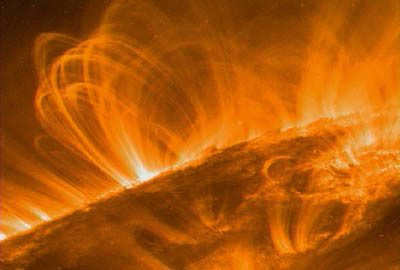
If you step outside on a clear evening, you’ll witness a myriad of stars. However, this is merely a small fraction of the countless stars in existence, only visible to the naked eye. Nevertheless, even among this limited selection, it’s easy to distinguish the brighter ones that have captivated human attention for centuries. Today, we’ll delve into the identity of the brightest star.
Undoubtedly, it’s an intriguing question, yet quite complex. Firstly, we must determine the criteria for brightness: relative or absolute. Consequently, this article will be divided into two sections. The first will explore the brightest stars visible from Earth’s surface, while the second will focus on the stars that radiate the most light.
Sol
Our Sol is the most brilliant star in the firmament. In relation to the vastness of the cosmos, it appears rather minuscule and somewhat lackluster. The majority of other celestial bodies are both larger and more radiant. However, for the sustenance of life on our world, its radiance is ideal: neither excessive nor blinding.
Nonetheless, its mass surpasses that of all other entities in the solar system, accounting for more than 99.866% of the total. Although the Sun is much closer to us than any other star, it still takes approximately 8 minutes for its light, which is the swiftest phenomenon in the entirety of the Universe, to reach us.
Countless similar facts exist, but the most crucial one is as follows: were the Sun to be nonexistent or even slightly altered, life on our planet would likewise cease to exist. Alternatively, it would manifest in vastly different forms. It prompts one to ponder what those forms might be.
Sirius
This celestial body is widely recognized as the most luminous star not only in the northern hemisphere but also in the southern hemisphere. It can be observed from nearly every location on Earth, with the exception of the higher latitudes in the north.
Since ancient times, Sirius has been revered and respected by people. The Greeks, for example, used its appearance as a marker for the start of their summer holidays, which coincided with the hottest period of the year. Even today, the term “dog days” is used to refer to this period, as a nod to the star’s other name – “canis,” meaning dog – in honor of the celestial hunter’s faithful companion, Sirius.
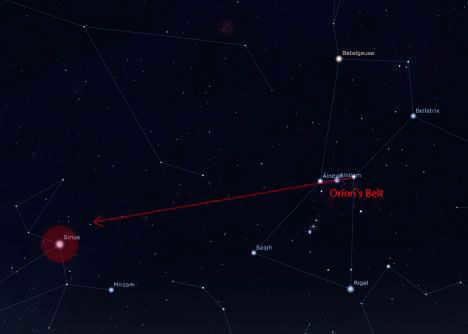
Practice at your own pace
The ancient Egyptians utilized Sirius as a means to determine the exact moment of the Nile’s flooding, which in turn marked the beginning of the sowing season. This celestial body held even greater significance for sailors, as it provided them with a guiding light while navigating the vast seas. In the present day, locating Sirius amidst the night sky is a simple task – just draw an imaginary line connecting three stars from Orion’s belt. Aldebaran marks one end of the line, while Sirius shines brightly at the other.
Sirius is actually a binary star system, consisting of the larger and brighter Sirius A and the white dwarf Sirius B. Therefore, like many other prominent stars, it is a binary system. Interestingly, it is also a part of the Big Dog constellation, adding to the overall “dog theme” associated with this star.
Furthermore, Sirius is situated relatively close to Earth, just 8 light years away. As a result, despite its relatively small size, being only 22 times larger than the Sun, it still shines as the brightest star in our sky.
Canopus
Also available for your reading pleasure:
What is the largest moon of Jupiter?
This celestial body is not just a rumor, like Sirius, but it is the second brightest star in our night sky. However, it is practically invisible from Russia and many other parts of the northern hemisphere.
On the other hand, for those in the southern hemisphere, it serves as a reliable guiding star. Sailors have long used it as a navigational aid, and even the Soviet astrocorrection systems relied on it as the primary star, with Sirius as the backup.
Interestingly, it also makes frequent appearances in science fiction literature. For instance, in Frank Herbert’s famous Dune series of novels, it is the name of the third planet in the Canopus system.
R136a1
The most brilliant and immense star in the observable cosmos hides behind these mysterious figures. By rough approximations, it outshines our Sun nine million times and dwarfs it in size by ten million-fold, yet it is only three hundred times its mass.
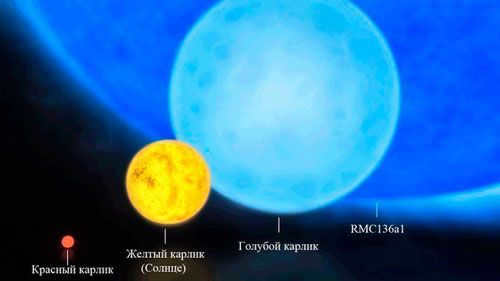
Experience the distinction
R126a1 was initially formed within a dense cluster of stars located in the Tarantula Nebula. Although it cannot be observed with the naked eye, this is solely due to its considerable distance from our planet: it is positioned 165,000 light-years away. However, even an ordinary amateur telescope possesses the capability to detect this enormous celestial body.
Due to its immense size and extraordinary temperature, R126a1 falls under the exclusive category of blue supergiants. These stars are scarce within the cosmos, rendering each one of them highly captivating to scientists. The most intriguing query pertains to the fate of this star upon its demise: will it transform into a black hole, a neutron star, or a supernova? While it is improbable for us to witness this event, scientists are unimpeded in their ability to construct models and formulate predictions.
VY CMa: The Brightest and Largest Star in Canis Major
In our previous discussions about constellations, we briefly touched upon the prominence of VY CMa in Canis Major. This unique star, also known as VY of the Big Dog, holds the distinction of being both incredibly bright and remarkably massive.
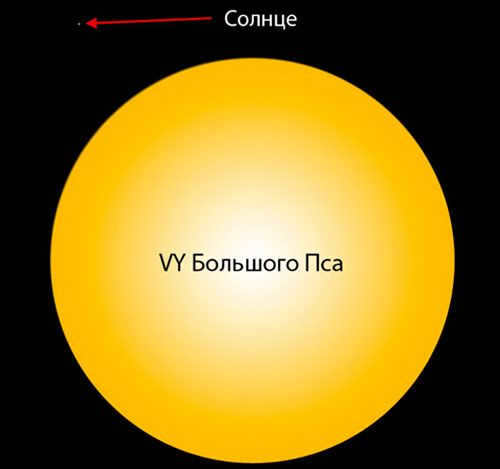
Take a look at that minuscule speck? That is the Sun
It is so immense that if you were to position it in the center of our solar system, its periphery would overlap Jupiter’s orbit just shy of Saturn’s orbit. If we were to trace its equatorial circumference in a straight line, it would require light 8.5 hours to traverse that distance. Its diameter is approximately 2,000 times the diameter of our Sun.
Meanwhile, the density of this celestial body is insignificant – roughly 0.01 grams per cubic meter. In comparison, the density of air is around 1.3 grams per cubic meter. A cube with edges spanning a kilometer would weigh roughly 10 tons. Nevertheless, this star remains exceedingly luminous.
Now that you have learned about the brightest star, your perspective on the night sky will be forever changed. There is truly a multitude of wonders to behold within it.

In the night sky, we are able to witness numerous stars that exhibit varying levels of luminosity, yet our perception of their brightness may not necessarily align with the reality of their luminosity in the vastness of space!
Under a clear night sky, an abundance of stars with different degrees of brightness can be observed. Naturally, these stars present themselves to us in a hierarchical order of luminosity. Several highly radiant stars have aroused the curiosity of ancient civilizations, leading to the creation of captivating tales and legends. Simultaneously, countless faint stars, which many may deem as “insignificant,” also populate the sky.
Nevertheless, are the bright stars we perceive from Earth truly luminous due to their emission of substantial amounts of energy and radiation? Or do they merely appear to possess such radiance from our vantage point on Earth?
To begin, it is important to acquire knowledge regarding the most luminous celestial bodies visible in the nocturnal firmament. At the top of the compilation is Sirius, which can be found in the constellation known as Canis Major, or the Big Dog. Following Sirius in sequence are the stars Canopus, Rigil Centaurus (also recognized as Alpha Centauri, the celestial system that is nearest to our planet, second only to our very own Sun), and Arcturus. It is worth noting that this particular ranking of luminosity is formulated from the perspective of Earth. In alternate star systems, it is highly probable that the aforementioned list would exhibit significant variations.
Stars’ Brightness Levels
A list of stars, ranked by their brightness, has been compiled by astronomers using a system known as stellar magnitudes.
This system was originally introduced by the ancient Greek astronomer and mathematician Hipparchus. He classified the brightest stars as “first magnitude” and the faintest stars as “sixth magnitude”. All other stars were given values of second, third, fourth, and fifth magnitudes, depending on their relative brightness levels. The magnitude system is arranged in reverse order, with smaller magnitudes indicating brighter stars.
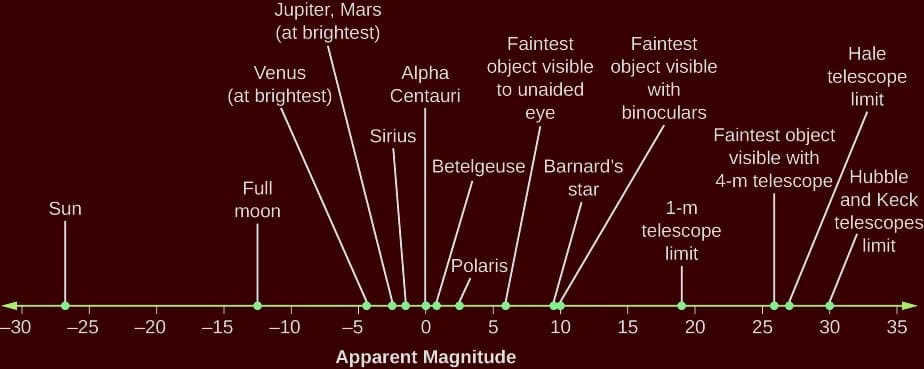
Over time, the scale that measures the brightness of stars visible from Earth has become more refined and is now officially referred to as the “apparent magnitude” scale. This scale takes into account stars that are much dimmer than what the human eye can perceive, as well as stars with zero and even negative magnitudes. For example, Sirius, the brightest star in the night sky, has an apparent magnitude of -1.46, while our Sun has an apparent magnitude of -26.72.
Mathematically, the apparent magnitude of a star is calculated using a logarithmic equation:
Where m represents the apparent magnitude and I represents the intensity or brightness of the two stars labeled A and B. It is important to note that this scale is relative. If star A is 100 times brighter than star B, then the apparent magnitude of star A will be five orders of magnitude lower (lower because the magnitudes are in reverse order of brightness) than that of star B.
It is crucial to understand that apparent magnitude does not directly measure the actual brightness of stars. The brightness of celestial objects when observed from Earth depends on two factors: the intensity of the radiation emitted by the object, which indicates the amount of energy (in the form of light) it emits, and the distance. Distance plays a significant role here. Even if a star is located at a considerable distance, it can still be visible to us if it emits enough light energy.
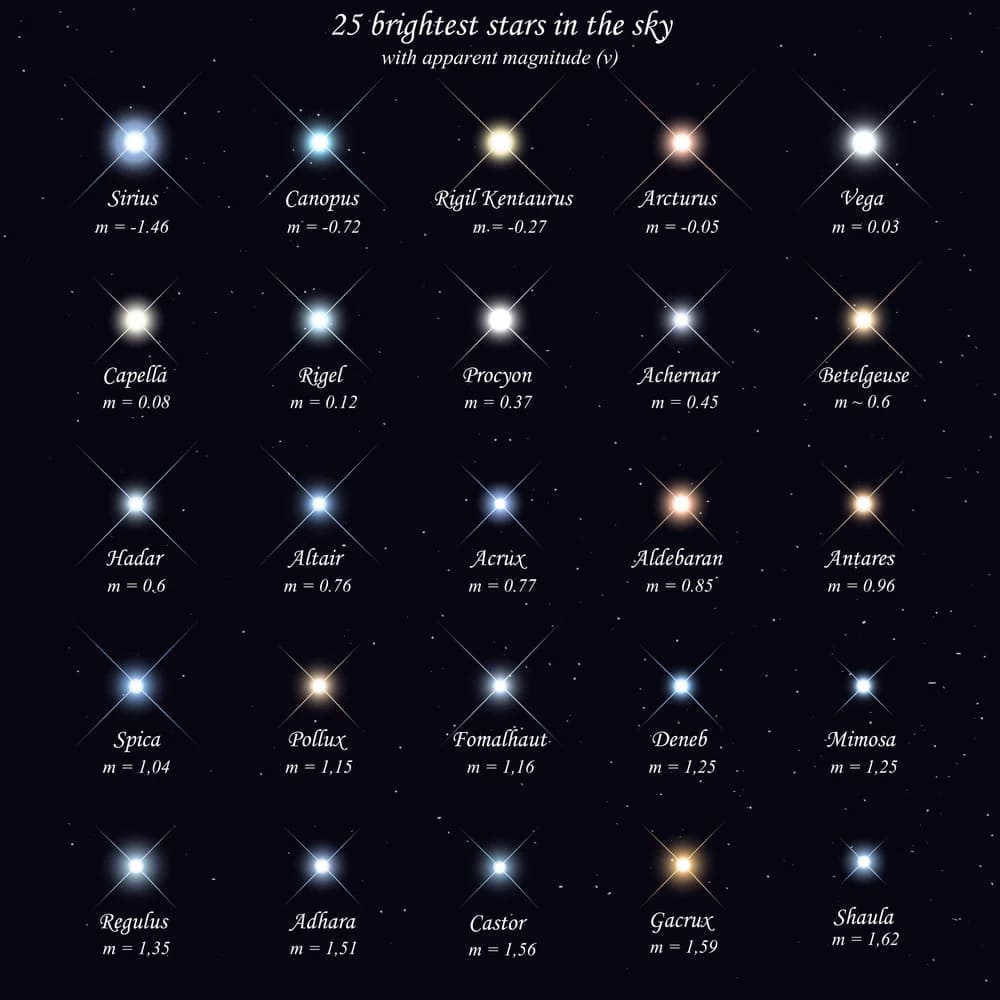
It is also possible that the light emitted by distant stars is scattered or blocked by particles of interstellar gas and dust. As a result, the star appears slightly dimmer when observed from Earth. However, this phenomenon has a negligible impact and is not considered in this research.
Absolute values
In order to consider the total amount of light emitted by stars, a different system known as absolute magnitude was developed. This system assigns magnitudes to stars based on their brightness if they were all observed from the same distance.
Specifically, the absolute magnitude of a star is equivalent to the apparent magnitude that would be observed if the object were 10 parsecs away. Therefore, absolute magnitude is a more precise measure of a star’s brightness because it only considers the intensity of its radiation, without factoring in distance.
We can determine the absolute magnitude of any celestial object using the following equation:
Where M represents the absolute magnitude of the object, m is the apparent magnitude, and d is the distance between Earth and the star.
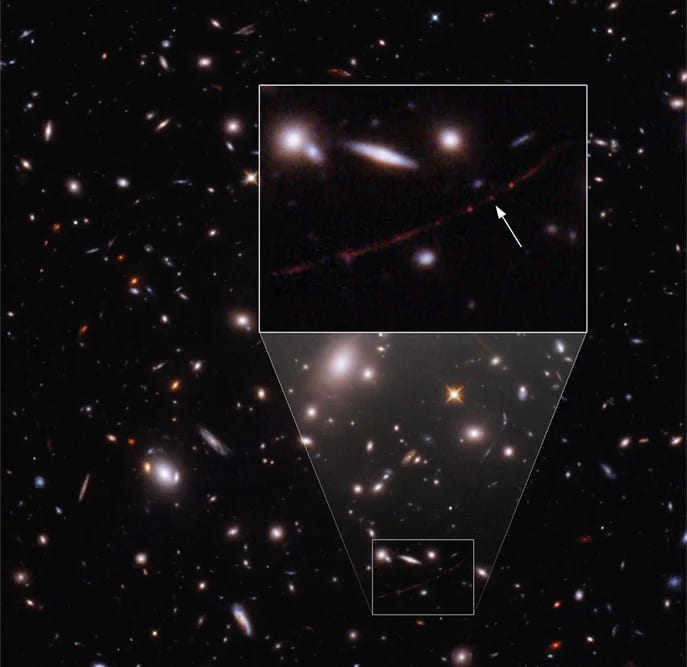
The absolute bolometric magnitude is another way to measure the intrinsic brightness of stars. Unlike the apparent and absolute magnitudes, which only consider visible light, the absolute bolometric magnitude takes into account the total radiation emitted by the star across all wavelengths. It also considers the electromagnetic radiation that would be observed if the star were 10 parsecs away from Earth, which is the same as the absolute magnitude.
Because the absolute bolometric magnitude accounts for all wavelengths of radiation, it can be seen as a more accurate indicator of a star’s intrinsic brightness. However, for the purposes of this paper, we will not be discussing the absolute bolometric magnitude.
Now, we will utilize both apparent and absolute magnitudes to gain insight into the extent of variation between the true luminosity of a star and the luminosity that we perceive here on Earth. Let’s consider the first two most luminous stars, Sirius and Canopus. Sirius has an apparent magnitude of -1.46 and an absolute magnitude of 1.43, while Canopus has an apparent magnitude of -0.72 and an absolute magnitude of -5.6. This indicates that even though Sirius appears brighter than Canopus from our vantage point on Earth, Canopus would actually outshine Sirius significantly if they were situated at the same distance from the observer.
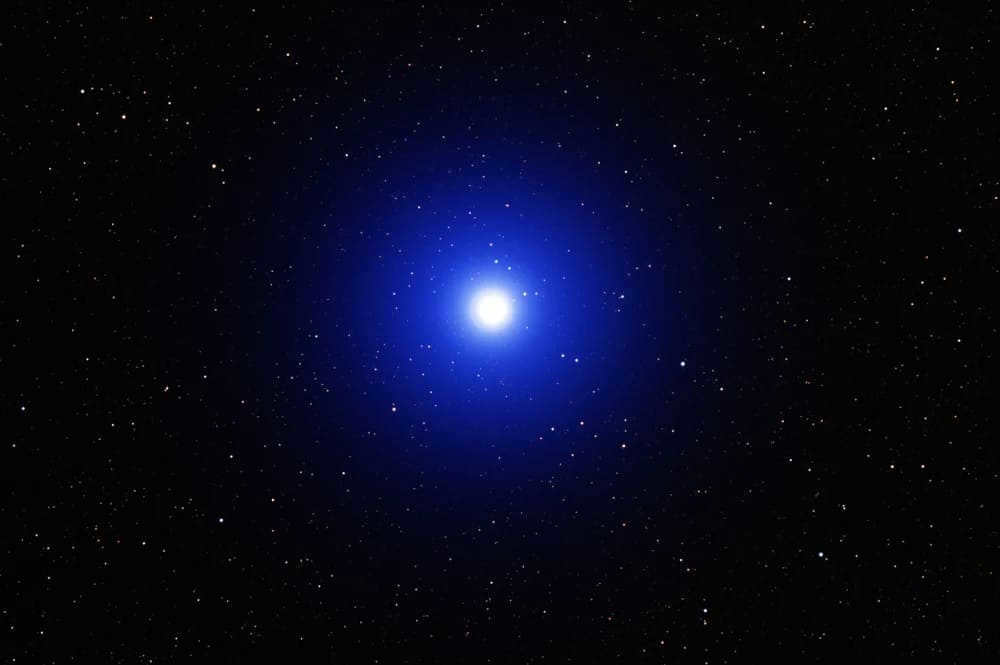
Evidently, what we observe does not provide us with the complete picture. Another instance is the star Rigel. In spite of being only the 7th most luminous star in the nocturnal sky with an apparent magnitude of 0.12, its absolute magnitude is -7.0, making it one of the stars with the greatest inherent brightness.
The primary factor behind this disparity is the differing distances of these stars from Earth. Sirius happens to be one of the nearest stars to our solar system and is just 8.6 light-years away, whereas Canopus is much further away at a distance of 309 light-years. Rigel, however, is approximately 860 light-years away from Earth, yet it still shines brighter than many others.
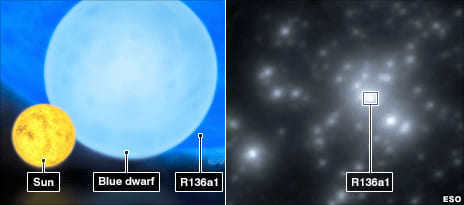
So, which star possesses the highest intrinsic luminosity? Answering this question is quite challenging. There are numerous stars whose absolute magnitudes have yet to be determined. Some potential contenders for this distinction include R136a1, the Pistol star, and BAT99-98. Nevertheless, a general guideline would be that extremely distant stars visible to us will have a high characteristic luminosity.
The key takeaway is that Sirius is not actually the most brilliant star. It only appears that way because it is relatively closer to us compared to most other stars. There are numerous stars that shine more brightly than Sirius, but unfortunately, they are unable to capture our attention due to their significant distance from Earth.
The determination of stellar brightness and the quantification of the total energy emitted by stars are essential in the development of numerical models for the formation of stars. Moreover, it facilitates our comprehension and investigation of stellar evolution and the various internal processes taking place within them. The observation and comprehension of stars with high levels of brightness play a critical role in expanding our understanding of star formation, which consequently enhances our knowledge of gas evolution in galaxies, supernovae, and other related phenomena.

Stars twinkle, every poet is aware of this phenomenon, but scientists have discovered that it is not solely caused by the refraction of light in the Earth’s atmosphere – the celestial bodies actually flicker from within. Thanks to a three-dimensional model, researchers have not only been able to witness this phenomenon, but also capture its sound.
The luminous dots in the sky shimmer in various hues, leaving us intrigued about the reasons behind this occurrence. Our constellation is home to numerous celestial bodies of different sizes and colors. These bodies emit light that travels through the layers of the atmosphere, which are heated and cooled, and get refracted along the way.
A recent study conducted by researchers at Northwestern University in Chicago has demonstrated that stars possess their own unique twinkling effect, which is caused by pulsating gas waves on their surface. Although this phenomenon cannot be observed through a telescope, it can be described as ethereal.
To capture this twinkling effect, scientists have created three-dimensional models that vividly depict the pulsations, which originate from the star’s core and resemble the motion of ocean waves. Moreover, these pulsating gas waves have been converted into sound waves, allowing us to audibly experience the twinkling of stars.
Chaotic Convection: A Phenomenon in Stars
Every star possesses a convective zone, which is a region where gases vigorously agitate, causing the heat to disperse outward. Convection, classified as a form of heat transfer, relies on the movement of gas or liquid streams to transport energy. Within the core of a star, a fascinating process unfolds: the scorching plasma ascends, releasing energy into the photosphere as it cools; subsequently, the cooled plasma descends, rewarms, and the cycle repeats itself. Remarkably, this mechanism mirrors the process that ignites thunderstorms: cooled air descends, warms up, and ultimately rises again.
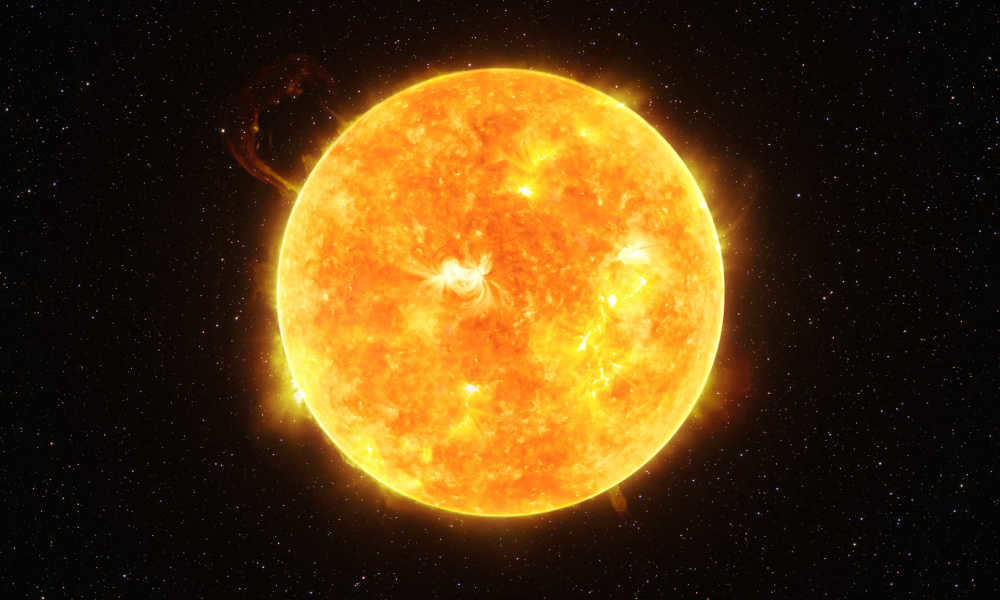
The Sun primarily transfers energy from its interior to its exterior through the process of convection, which involves active mixing of matter. Photo: © Lukasz Pawel Szczepanski / Shutterstock / FOTODOM
Gas waves also operate in a similar manner, with small streams causing starlight to dim and brighten, resulting in a subtle flickering effect.
In massive stars that are at least twice the size of the Sun, convection occurs within the core. Since the core of these massive stars is not visible, scientists have attempted to simulate the hidden convection process.
Observe the vibration of the Sun
In the early 1960s, a team of astrophysicists from the California Institute of Technology witnessed the phenomenon of convection occurring in the outer layers of the Sun. They witnessed plasma bubbles, measuring approximately 10 thousand kilometers in diameter, rising and falling on the Sun’s surface at a speed of around 500 meters per second and with a period of 296 seconds. These were the well-known oscillations of the Sun, commonly referred to as P-waves or pressure waves.
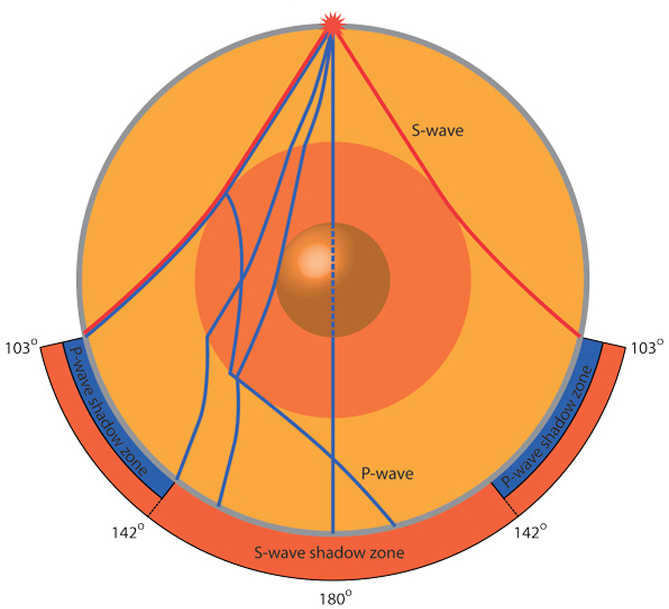
Short wavelength waves are situated closer to the surface of the Sun, while longer wavelength waves penetrate deeper into the star’s core. Image: ESA
By analyzing the properties of turbulent convection in the core, the properties of the waves, and potential observable phenomena associated with these waves, researchers were able to forecast the fluctuations in the star’s brightness caused by convection-generated waves.
The Melody of the Celestial Bodies
Deep within the heart of a star lies the epicenter of powerful thermonuclear reactions. It is here that energy is birthed, subsequently making its way to the star’s outer layers. This phenomenon can be likened to the way the heat from an electric stove transfers to the bottom of a kettle, causing it to emit a sonorous hum.
Similarly, in the vast expanse of space, stars emit heat energy through convection, accompanied by jets of ascending matter. As the outer layers of these stellar bodies undergo convection, they produce enchanting sound waves. But how does one listen to these celestial melodies?
Through the creation of a comprehensive model depicting the journey of energy from a massive star’s core to its outer surface, scientists have ingeniously transformed this data into audible sound waves, allowing us to perceive the resplendent “flicker” of these celestial entities. And thus, a harmonious symphony is born.





